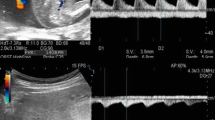Abstract
Background
Twin reversed arterial perfusion sequence (TRAP) is a rare complication in multifetal monochorionic pregnancies in which a normal “pump” twin provides circulation to an abnormal acardiac co-twin, resulting in high-output cardiac dysfunction in the pump twin.
Objective
To define fetal MRI findings of TRAP sequence.
Materials and methods
Fetal MR images were retrospectively reviewed in 35 pregnancies complicated by TRAP sequence. Abnormalities of the pump twin, acardiac twin, umbilical cord, placenta and amniotic fluid were reviewed.
Results
Acardiac twins were classified as: acephalus (51%), anceps (40%), amorphus (9%), acormus (0%). Common findings in acardiac twins include subcutaneous edema (77%), absent cardiac structures (86%), absent or abnormal thoracic cavity (100%), abnormal abdominal organs (100%), superior limbs absent (46%) or abnormal (51%), and inferior limbs present but abnormal (83%). There were pump twin findings of cardiac dysfunction in 43% and intracranial ischemic changes in 3%. Umbilical cord anomalies were present in 97%.
Conclusion
Acardiac twins present with a predictable pattern of malformation with poorly developed superior structures, more normally formed inferior structures and absent or rudimentary heart. Although usually absent, abnormal heart structures can be seen and do not exclude TRAP sequence. Pump twins are commonly normal with exception of findings of cardiac dysfunction and possible brain ischemia.










Similar content being viewed by others
References
Moore TR, Gale S, Benirschke K (1990) Perinatal outcome of forty-nine pregnancies complicated by acardiac twinning. Am J Obstet Gynecol 163:907–912
Steffensen TS, Gilbert-Barness E, Spellacy W et al (2008) Placental pathology in TRAP sequence: clinical and pathogenetic implications. Fetal and Pediatr Pathol 27:13–29
Brassard M, Fouron JC, Leduc L et al (1999) Prognostic markers in twin pregnancies with an acardiac fetus. Obstet Gynecol 94:409–414
Healey MG (1994) Acardia: predictive risk factors for the co-twin’s survival. Teratology 50:205–213
Livingston JC, Lim J-Y, Polzin W et al (2007) Intrafetal radiofrequency ablation for twin reversed arterial perfusion (TRAP): a single-center experience. Am J Obstet Gynecol 197(399):e1–3
Tso K, Feldstein VA, Albanese CT et al (2002) Selective reduction of acardiac twin by radiofrequency ablation. Am J Obstet Gynecol 187:635–640
Sebire NJ, Wong AE, Sepulveda W (2006) Minimally invasive management of twin reversed arterial perfusion sequence (TRAP). Fetal and Maternal Medicine Review 17:1–22
Hata N, Wada T, Kashima K et al (2005) Non-gated fetal MRI of umbilical blood flow in an acardiac twin. Pediatr Radiol 35:826–829
Stiller RJ, Romero R, Pace S et al (1989) Prenatal identification of twin reversed arterial perfusion syndrome in the first trimester. Am J Obstet Gynecol 160:1194–1196
Yomoah KK, Kotlinska MA, Coady AM et al (2009) Twin reversed arterial perfusion syndrome: the role of ultrasound in diagnosis and management. Ultrasound 17:227–230
Schwarzler P, Ville Y, Moscosco G et al (1999) Diagnosis of twin reversed arterial perfusion sequence in the first trimester by transvaginal color Doppler ultrasound. Ultrasound Obstet Gynecol 13:143–146
Baron M, Verspyck E, Diguet A et al (2009) Sonographic findings of acardiac twin in the first trimester of pregnancy. J Gynecol Obstet Biol Reprod (Paris) 29:684–686
Kamitomo M, Kouno S, Ibuka K et al (2004) First trimester findings associated with twin reversed arterial perfusion sequence. Fetal Diagn Ther 19:187–190
Billah KL, Shah K, Odwin C (1984) Ultrasonic diagnosis and management of acardiac acephalus twin pregnancy. Med Ultrasound 8:108
Tan TY, Sepulveda W (2003) Acardiac twin: a systematic review of minimally invasive treatment modalities. Ultrasound Obstet Gynecol 22:409–419
Weisz B, Peltz R, Chayen B et al (2004) Tailored management of twin reversed arterial perfusion (TRAP) sequence. Ultrasound Obstet Gynecol 23:451–455
Hadlock FP, Harrist RB, Sharman RS et al (1985) Estimation of fetal weight with the use of head, body, and femur measurements—a prospective study. Am J Obstet Gynecol 151:333–337
Sepulveda W, Steir D, Reyes M et al (2000) Severe polyhydramnios in twin reversed arterial perfusion sequence: successful management with intrafetal alcohol ablation of acardiac twin and amniodrainage. Ultrasound Obstet Gynecol 16:260–263
Van Allen MI, Smith DW, Shepard TH (1983) Twin reversed arterial perfusion (TRAP) sequence: a study of 14 twin pregnancies with acardius. Semin Perinatol 7:285–293
Author information
Authors and Affiliations
Corresponding author
Rights and permissions
About this article
Cite this article
Guimaraes, C.V.A., Kline-Fath, B.M., Linam, L.E. et al. MRI findings in multifetal pregnancies complicated by twin reversed arterial perfusion sequence (TRAP). Pediatr Radiol 41, 694–701 (2011). https://doi.org/10.1007/s00247-010-1921-2
Received:
Revised:
Accepted:
Published:
Issue Date:
DOI: https://doi.org/10.1007/s00247-010-1921-2




